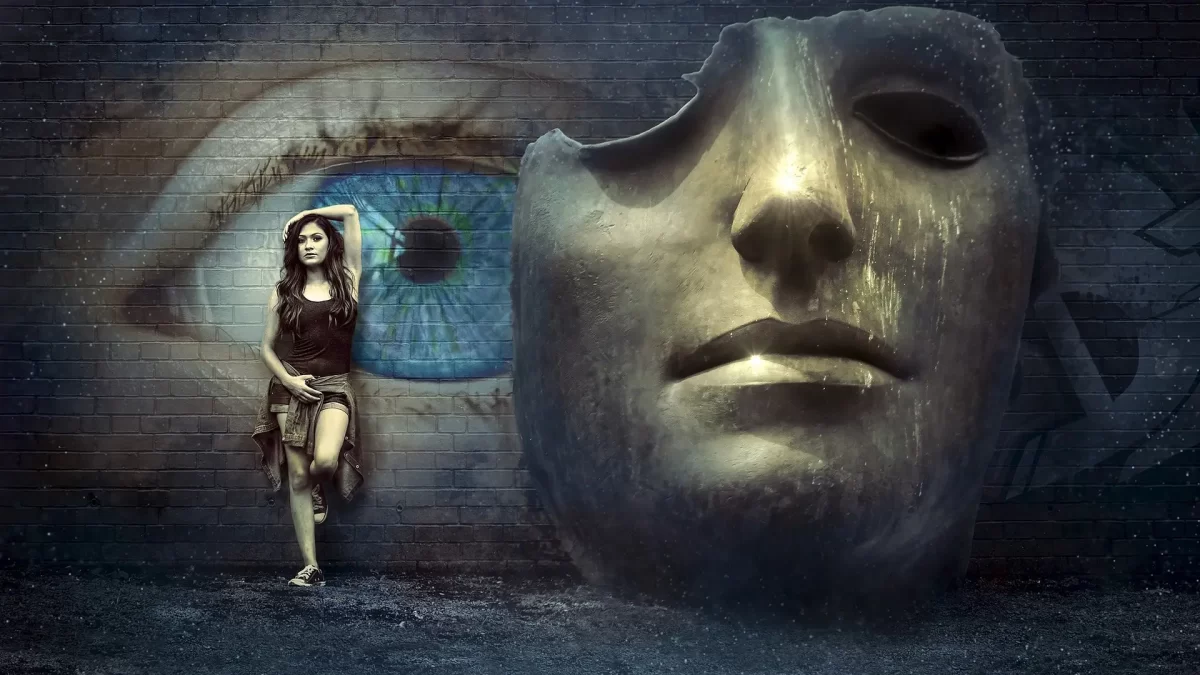Imagine a moment when a single piece of art not only captures your eye but stirs something deep within—a revelation that changes the way you see the world and yourself. Conceptual art is not just about abstract ideas; it’s a gateway to self-exploration, emotional healing, and personal transformation.
In an era where creativity meets mindfulness, individuals are discovering that engaging with conceptual art can be a profound tool for self-discovery. Whether you’re an artist, a therapist, or someone in search of deeper meaning, this journey into the healing power of art will inspire you to embrace your personal narrative, practice mindfulness, and integrate art effortlessly into your everyday life.
Art as a Tool for Self-Discovery
Conceptual art challenges traditional notions of beauty and objectivity by emphasizing ideas over physical forms. This unique approach allows viewers to interpret art through their own personal lens. When you engage with conceptual art, you aren’t just witnessing an idea—you are invited to reflect, question, and embark on a journey of self-exploration.
The Transformative Power of Art
- Emotional Healing: Art has long been recognized for its therapeutic benefits. Through creative expression, individuals process past traumas, celebrate victories, or simply find solace in a chaotic world. Research has shown that engaging in art therapy can reduce anxiety, depression, and emotional distress | Meaning, Benefits & Activities](https://www.calmsage.com/mindfulness-based-art-therapy/).
- Cognitive Shifts: As you interact with conceptual pieces that challenge conventional aesthetics, you cultivate a mindset of curiosity and critical thinking. This introspection opens pathways to understand your own values, desires, and potential.
- Self-Expression: In many cases, the act of creating or critically observing art can lead to personal breakthroughs. As artists like Frida Kahlo and Vincent van Gogh have demonstrated, art is a language of emotions that speaks directly to the soul.
By viewing each art piece as a mirror reflecting your inner world, you set off a journey toward discovering hidden parts of yourself. Art becomes more than decoration—it transforms into a dynamic tool for self-analysis and emotional growth.
Personal Narratives & Storytelling
Our lives are stories in progress, and art often plays a starring role in narrating our personal journeys. Conceptual art invites you to explore your narrative in ways that traditional forms rarely do.
The Power of Storytelling in Art
- Personal Testimonies: Think of a time when viewing an abstract installation or a thought-provoking sculpture evoked memories or emotions—maybe it reminded you of a loved one, a challenge you overcame, or a dream yet to be fulfilled.
- Shared Experiences: Across cultures and generations, stories told through art have the power to resonate deeply, forging connections between seemingly disparate lives. For instance, many artists use their work to comment on societal issues and personal struggles, which in turn, provide solace and inspiration to others who see parts of their own journey reflected in the art.
Case Study: A Journey of Rediscovery
Consider the story of Maya, a professional who found herself in a state of emotional burnout. Feeling disconnected from her true self, she began attending conceptual art exhibitions and later joined a creative workshop based on art therapy. Over time, each brushstroke and installation provided Maya with the tools to reflect on her experiences, express her hidden emotions, and slowly rebuild her identity. Today, she credits her renewed sense of purpose to the moments of clarity fostered by these artistic encounters.
By sharing and embracing these personal narratives, conceptual art becomes a beacon of hope and a guide on the path to self-discovery. It encourages you to write your own story, one that is uniquely yours yet universally resonant.
Mindfulness & Art Therapy Techniques
Integrating mindfulness with art therapy is a powerful approach that facilitates emotional healing and personal development. Conceptual art’s inherent emphasis on ideas creates a natural synergy with mindfulness practices that center on being present and self-aware.
What is Mindfulness-Based Art Therapy (MBAT)?
Mindfulness-Based Art Therapy (MBAT) combines traditional art therapy with mindfulness practices, such as meditation and breathing exercises, to help individuals access deeper layers of their consciousness. By engaging in art mindfully, you allow yourself to experience a state of flow that can lead to enhanced emotional awareness and stress reduction | Meaning, Benefits & Activities](https://www.calmsage.com/mindfulness-based-art-therapy/).
How MBAT Works:
- Focused Creativity: MBAT uses art as a medium to focus the mind. Whether it’s drawing, painting, or sculpting, the creative process forces you to concentrate on the present moment, diverting thoughts away from past regrets or future worries.
- Mindful Observation: Instead of passively viewing an artwork, MBAT encourages you to engage with it fully—notice colors, textures, and ideas. This attentive observation can mirror moments of meditation, where every detail of the art serves as an anchor to the present.
- Emotional Release: The process of creating art provides an outlet for pent-up emotions. As you work through difficult feelings, you learn to express and eventually release them, paving the way for healing.
Practical Art Therapy Techniques
- Guided Imagery: Sit comfortably, close your eyes, and imagine a scene that reflects your inner world. Then, translate these images onto paper. This exercise bridges the gap between your inner emotions and external expression.
- Creative Journaling: Combine writing and art by creating a visual diary. Use sketches, collages, and colors to represent your daily experiences or emotional states. Over time, this journal can serve as a powerful record of your personal growth.
- Meditative Doodling: Allow your hand to move freely over paper without a specific goal. This form of doodling can be an effective meditative practice, reducing stress and sparking unexpected insights.
For more in-depth strategies, check out our Art Therapy Hub where we dive into tools and techniques that blend mindfulness with creative expression.
The Role of Creative Expression
Creative expression is at the heart of personal growth. Through conceptual art, you are not merely an observer but an active participant in the creative process.
Unlocking Self-Expression through Art
- Breaking Down Internal Barriers: Engaging in creative practices enables you to break down internal walls built over years of repression or routine. Whether through painting, sculpting, or writing, each creative act is a declaration of your individuality and a step toward embracing your true self.
- Developing Emotional Resilience: Creative expression empowers you to articulate things that words might fail to capture. As you explore abstract concepts and sensory experiences through art, you build emotional resilience—a valuable trait in navigating life’s ups and downs.
- Fostering a Growth Mindset: Creativity nurtures curiosity and a willingness to explore the unknown. This mindset directly contributes to personal development by encouraging you to view challenges as opportunities for learning and growth.
Real-Life Success Stories
- Testimonial from an Art Therapist: “I’ve seen countless individuals transform their lives by simply incorporating art into their routine. One client, struggling with chronic anxiety, began a daily practice of sketching her emotions. Over time, her visual journal not only became a therapeutic outlet but also a testament to her journey toward self-acceptance,” says Jamie Rivera, a certified art therapist.
- A Personal Journey: John, a mid-career professional, rediscovered his passion for exploration and creativity after engaging with conceptual art. His daily ritual of visiting local galleries and participating in community art events gradually helped him overcome feelings of stagnation and isolation, leading to renewed inspiration in both his personal and professional life.
These narratives illustrate that creative expression is not just about making art—it’s about making life more vibrant, meaningful, and resilient.
Integrating Art in Everyday Life
Incorporating art into your daily routine can enhance not only your aesthetic experience but also your overall emotional well-being. Conceptual art invites you to look beyond traditional galleries and find beauty and meaning in every moment.
Actionable Strategies for Daily Art Engagement
- Morning Rituals: Start your day with a creative burst. Set aside 10 minutes for free drawing or doodling to kickstart your mind with positivity and openness.
- Personal Art Journal: Keep a small sketchbook or digital tablet handy. Use it to capture fleeting emotions, ideas, or moments of inspiration throughout the day.
- DIY Art Projects: Create simple, personal art projects at home—whether it’s customizing a coffee mug, designing a vision board, or rearranging your living space to incorporate elements of art.
- Community Events: Take part in local art events, workshops, or open mic nights. Not only do these foster a sense of community, but they also expose you to diverse creative perspectives.
- Mindful Coloring: Adult coloring books are becoming a popular tool for reducing stress. Spend a few quiet minutes each evening filling in intricate designs and color patterns as a form of meditation.
By integrating artistic practices into everyday situations, you can transform your routine into a continuous journey of self-enhancement and personal development.
Table: Integrating Art into Daily Life
| Area | Actionable Tip | Expected Benefit |
|---|---|---|
| Morning Rituals | Spend 10 minutes doodling or journaling | Kickstart creativity and set a positive tone |
| Digital Journaling | Use a tablet or sketchbook for daily artistic notes | Enhance self-reflection and capture inspiration |
| DIY Projects | Customize everyday objects to reflect your personality | Boost creativity and personal satisfaction |
| Community Engagement | Attend local art classes & exhibitions | Build networking and gain fresh insights |
| Mindful Coloring | Color intricate patterns as a stress-relief method | Reduce anxiety and promote relaxation |
These simple steps make art an integral and transformative part of your daily life.
The Healing Power of Art
The psychological benefits of engaging with conceptual art are profound. Art therapy is not just a buzzword—it’s a scientifically backed approach that fosters emotional well-being and personal growth.
Psychological Benefits and Art Therapy Fundamentals
- Stress Reduction: Numerous studies have shown that art therapy helps in lowering cortisol levels (the stress hormone) and enhances overall emotional regulation.
- Enhanced Self-Awareness: By creating art, you open up channels for self-exploration, allowing hidden emotions and thoughts to surface for inspection.
- Improved Communication: Artistic expression often enables individuals to convey complex feelings when words fall short. This can lead to breakthroughs in self-understanding and interpersonal communication.
Art engages the brain in a holistic manner, connecting emotional, cognitive, and sensory experiences. The interplay of colors, shapes, and abstract ideas can spark a gentle yet deep transformation—one that nurtures resilience and inner strength.
Inspirational Case Studies
- Case Study: Rediscovering Identity through Art Therapy
In one documented case, a woman recovering from a prolonged bout of depression used regular art therapy sessions to reconnect with her inner self. Through creative exercises such as guided painting and collage-making, she gradually rebuilt her self-esteem and a sense of purpose. - Art Therapist Interviews:
In interviews published on platforms like Riverside Artists, art therapists speak of clients who have found empowerment through conceptual art, turning their creative process into a reflective mirror that shows who they truly are.
These real-life examples underscore the transformative power of art—not merely as a pastime, but as a critical component in the journey toward emotional healing and self-improvement.
Mindfulness Practices and Creative Workshops
In today’s fast-paced world, integrating mindfulness into your creative routines can be transformative. The practice of mindful art-making enables you to fully engage with your senses and emotions, leading to deeper personal insights and improved mental well-being.
Techniques for Mindful Art-Making
- Mindful Observation: Sit quietly in front of a piece of art—whether in a gallery or online—and observe every detail. Notice the interplay of light, shadow, and texture. Let your thoughts flow without judgment.
- Guided Artistic Meditation: Combine voluntary meditation with periodic pauses to sketch or journal. This hybrid practice helps ground your creativity in the present moment.
- Creative Journaling: Use art journaling as a meditative tool. Add words, sketches, and collages that capture your emotional state and evolving thoughts. Not only does this technique reduce anxiety, but it also promotes self-discovery and clarity.
Join a Creative Workshop
Attending art workshops and group sessions can amplify the benefits of mindfulness:
- DIY Art Projects: Participate in guided sessions where you build a piece of art from scratch under the guidance of an art therapist.
- Community Art Events: Join group activities where collective creativity fosters a sense of belonging and shared healing.
- Online Classes: Many platforms now offer virtual workshops that blend conceptual art tutorials with mindfulness training, making these practices accessible regardless of location.
For more ideas on mindful art practices, check out resources such as the Mindfulness-Based Art Therapy Guide to explore techniques and success stories.
Integrating Art in Your Lifestyle
Making art a part of your everyday routine can have lasting benefits, affecting both your personal and professional life. Here are some practical ways to bring the transformative power of conceptual art into your lifestyle:
Daily Practices for Art Appreciation
- Morning Inspirations: Dedicate a few minutes each morning to view a piece of art online or in your personal collection. Let the imagery inspire your day.
- Walk and Wonder: During walks, take time to notice public art installations or murals in your area. Use these discoveries as a chance to reflect on your journey.
- Create a Dedicated Space: Designate a corner at home as your creative sanctuary with art prints, inspirational quotes, and comfortable seating to encourage reflection.
- Social Engagement: Participate in local art meetups or virtual clubs. Sharing creative experiences with others can deepen your relationship with art and foster community connections.
Lifestyle Benefits
- Emotional Resilience: Regular art engagement builds tools to process and navigate complex emotions.
- Increased Creativity: Infusing everyday activities with artistic expression sparks innovation and fresh ideas in other areas of life.
- Mindfulness and Stress Relief: Continuous practice of art appreciation and creation can serve as an everyday meditation, helping to stabilize mood and improve overall well-being.
By integrating these practices, you transform art from a passive experience to an active, transformative part of your daily life.
FAQ: People Also Ask
Q1: How can conceptual art help with personal growth?
A: Conceptual art prioritizes ideas and emotions, encouraging self-reflection, creativity, and emotional healing. It serves as both an inspirational mirror and a tool to process personal experiences.
Q2: What are some mindfulness techniques I can combine with art therapy?
A: You can try guided meditative drawing, creative journaling, and mindful observation of art. These practices help you focus, reduce stress, and increase self-awareness.
Q3: Can art therapy be used for emotional healing?
A: Yes, art therapy has proven psychological benefits such as reducing anxiety, enhancing self-expression, and promoting emotional resilience. Many therapists incorporate art techniques into their counseling practices.
Q4: How do I integrate art into my daily routine?
A: Start with simple practices like morning doodles, maintaining a visual journal, attending local art events, or creating a dedicated creative space in your home.
Q5: Where can I learn more about conceptual art and its impact on personal growth?
A: Explore resources like the Art Therapy Hub and mindfulness-based art therapy guides on platforms like CalmSage and Verywell Mind.
Custom Image Suggestion and Infographic Idea
Infographic Idea:
Create an infographic titled “Artistic Journeys: How Conceptual Art Fuels Personal Growth”. This infographic should include:
- Key psychological benefits of art therapy
- Steps for integrating mindfulness in art-making
- Tips for daily art practices and creative expression
Alt Text: “Infographic illustrating the transformative journey of personal growth through conceptual art, highlighting mindfulness techniques and daily creative practices.”
Social Sharing Hooks
- Inspired by this journey? Share this article on LinkedIn, Twitter, and Facebook with the hashtag #ArtisticJourneys.
- Join the conversation: Comment below with your experiences of how art has transformed your life.
- Keep up with creative growth: Follow our social media pages for tips, workshops, and inspirational art stories.
Conclusion & Call to Action
The transformative journey of personal growth through conceptual art is both profound and accessible. From utilizing art as a tool for self-discovery to integrating mindfulness-based art therapy techniques, you have the power to harness creativity for emotional healing and personal development. Each brushstroke, sketch, and inspired moment becomes a stepping stone on the path to self-understanding and renewal.
Are you ready to transform your life through art?
- Explore More: Visit our Creative Expression Zone for more resources on art therapy and mindfulness practices.
- Subscribe: Join our newsletter for regular updates on art-based personal growth, workshops, and inspirational stories.
- Engage: Share this article with friends and join our online community where art and personal development intersect.
Let your creative journey begin today—embrace the power of conceptual art, meditate on its messages, and transform your life one masterpiece at a time.
Thank you for joining us on this exploration of art as a transformative tool. Stay curious, keep creating, and remember: every piece of art tells a story—yours is waiting to be revealed.




